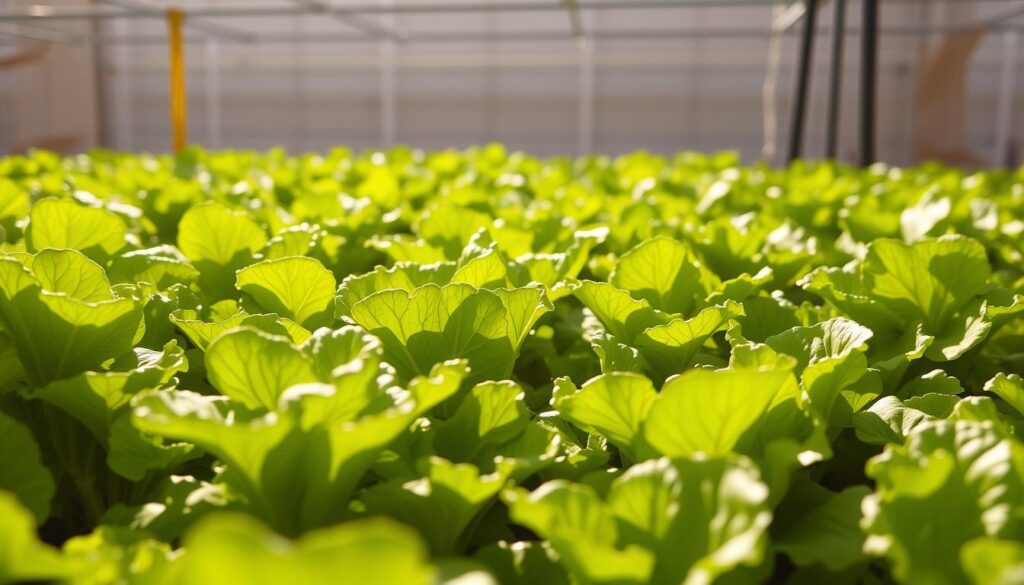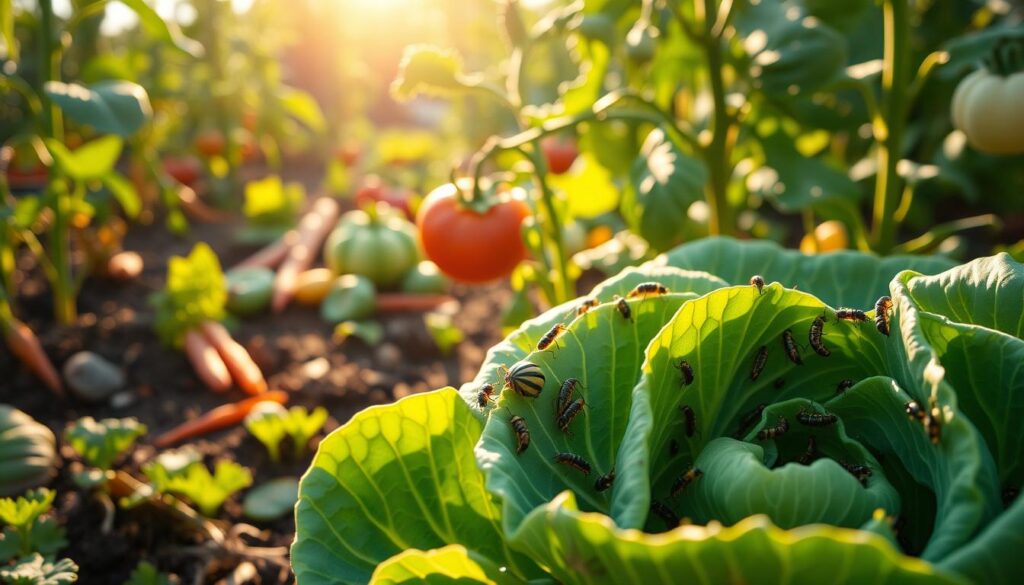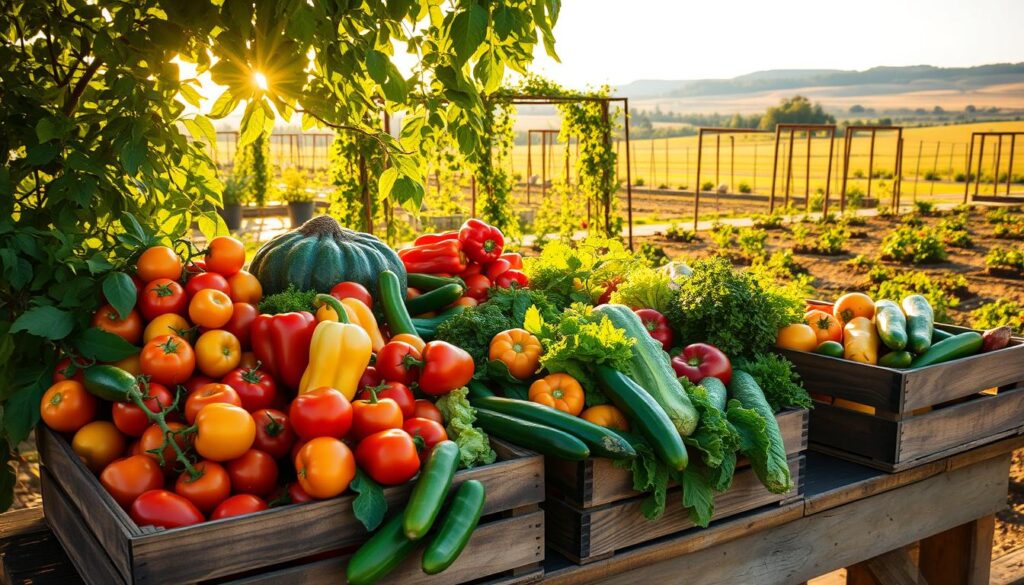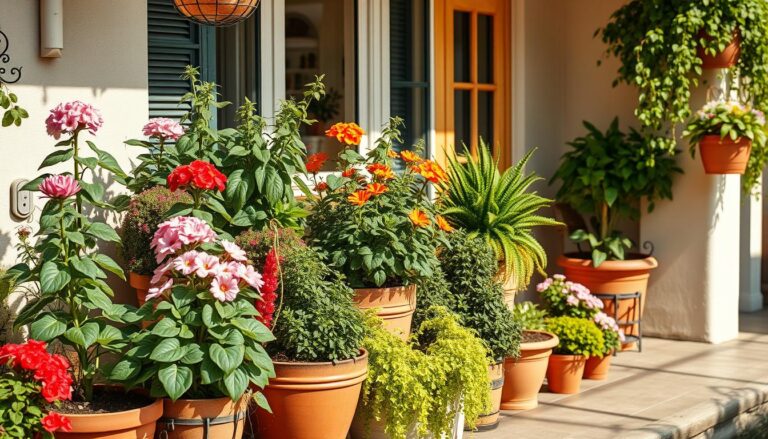Vegetable Gardening 101: Start Your Backyard Garden Today
This post contains affiliate links, meaning I may receive a small commission if you make a purchase through my links, at no extra cost to you.
Growing your own food is very rewarding. There’s something special about enjoying a fresh salad made from the fruits of your labor. If you love eating fresh produce, you’ll be surprised at how easy it is to start a Diy Vegetable Garden in your backyard.
Vegetable gardening not only gives you fresh produce but also lets you control what goes into growing your food. By following some simple Gardening Tips, you can create a thriving garden. This garden will provide you with delicious meals all season long.
Key Takeaways
- Start small and choose easy-to-grow vegetables.
- Follow simple Gardening Tips for a successful harvest.
- Enjoy the benefits of fresh, homegrown produce.
- Take control of what goes into growing your food.
- Create a thriving Diy Vegetable Garden in your backyard.
Understanding the Benefits of Vegetable Gardening
Growing your own vegetables can change your life. It’s good for your health, saves money, and helps the environment. A vegetable garden brings many benefits that improve your life.
Health Benefits of Growing Your Own Vegetables
One big plus of vegetable gardening is getting fresh, healthy food right in your yard. You can pick your veggies at their best. This means you and your family get to eat the freshest, most nutritious food.
Homegrown veggies are full of vitamins, minerals, and antioxidants. They’re also free from harmful chemicals and pesticides. This makes them a healthier choice for you and your family.
Vegetable gardening also encourages a healthier lifestyle. It’s a fun, active way to take care of your garden. Plus, you can add Medicinal Herbs Garden to your garden for natural health remedies.
Environmental Impact of Home Gardening
Vegetable gardening is good for the planet. It reduces your need for industrial farming and transportation, which pollute the air. Home gardens also support biodiversity by providing homes for beneficial insects and wildlife.
Using Organic Compost in your garden helps reduce waste and improves soil health. This creates a healthy environment for beneficial microorganisms.
Vegetable gardening also helps save water and resources. By using sustainable gardening practices, you can make a big difference for the planet.
Financial Savings Through Vegetable Gardening
Vegetable gardening can also save you money. By growing your own food, you cut down on grocery bills. You can also preserve your harvest to enjoy it all year.
A well-kept vegetable garden can even increase your property value. By using Organic Compost and sustainable practices, you create a valuable asset for your home.
Planning Your Vegetable Garden Layout
Before you start planting, it’s key to plan your garden layout. This ensures your plants get enough sunlight, water, and nutrients. A well-planned garden also looks great and boosts your yard’s appeal.
Choosing the Right Spot in Your Yard
Finding the right spot for your garden is crucial. A bad spot can lead to poor veggies. Here are some tips for picking a good site:
- Look for a sunny spot with at least 6 hours of direct sunlight a day.
- Make sure the area drains well to avoid waterlogged soil.
- Choose a spot that’s stable and not windy to protect your plants.

Understanding Sunlight and Drainage Needs
Knowing your garden’s sunlight and drainage needs is vital. Most veggies need full sun to grow well. Keep these points in mind:
- Sunlight requirements: Different veggies need different amounts of sun. Leafy greens can handle some shade, but tomatoes and peppers need full sun.
- Drainage needs: Your garden should drain well to avoid soggy soil. Adding compost or manure can help improve drainage.
Designing Rows or Raised Beds
When designing your vegetable garden beds, you can choose between rows or raised beds. Here’s what to consider:
- Raised beds: They offer better drainage, soil structure, and warmer soil. Raised beds are great for bucket gardening and can be made from wood, stone, or composite materials.
- Rows: Traditional row gardening is another option. It’s used for larger gardens and can be more work.
By thinking about these factors and planning a good veggie garden layout, you can create a thriving garden. It will meet your needs and give you a great harvest.
Selecting the Best Vegetables for Your Garden
For a thriving vegetable garden, start with easy-to-grow and productive vegetables. Whether you have a big backyard or a small balcony, picking the right vegetables is key. This ensures a successful harvest.
Popular Vegetables for Beginners
Beginners should start with vegetables that are easy to grow and need little care. Tomatoes, cucumbers, zucchini, and leafy greens like lettuce and spinach are great choices. They are easy to grow and can be used in many dishes.
Strawberries are also a great choice for beginners. They grow quickly, produce fruit fast, and do well in containers. This makes them perfect for small spaces like apartment balconies.
Seasonal Planting Guide
Knowing when to plant is crucial for a good harvest. Different vegetables grow best in different seasons. For example, cool-season crops like broccoli and carrots do well in spring or fall. Warm-season crops like tomatoes grow best in summer.
| Season | Vegetables to Plant |
|---|---|
| Spring | Broccoli, Kale, Carrots, Lettuce |
| Summer | Tomatoes, Peppers, Eggplants, Cucumbers |
| Fall | Spinach, Radishes, Green Beans, Beets |
Companion Planting Essentials
Companion planting involves growing different vegetables together to improve their growth and health. For example, marigolds can help protect tomatoes from nematodes. Basil near tomatoes can also enhance their flavor.

By using companion planting, you can create a balanced and thriving garden. This technique not only helps your vegetables grow better but also makes your garden more diverse and resilient.
Preparing H2: Preparing Your Soil for Vegetable Planting
The quality of your soil is key to healthy vegetable plants. To have a Dream Vegetable Garden, you must prepare your soil well.
First, understand your soil’s current state. This means testing its quality and pH.
Testing Soil Quality and pH
Soil testing kits are easy to find at gardening stores or online. They show your soil’s pH and nutrient levels. Most veggies like a slightly acidic to neutral soil pH, between 6.0 and 7.0.
To test your soil, just follow the kit’s instructions. After getting the results, you can adjust your soil as needed.
| Soil pH | Nutrient Availability |
|---|---|
| Acidic (pH 6.0) | Lower availability of nutrients like nitrogen and phosphorus |
| Neutral (pH 7.0) | Optimal availability of most nutrients |
| Alkaline (pH 8.0) | Lower availability of micronutrients like iron and zinc |
Enriching Soil with Organic Matter
Adding organic matter improves soil structure and fertility. Compost, manure, or peat moss can be mixed in. Even a small amount can greatly benefit a Mini Vegetable Garden.
Organic matter enhances soil drainage, aeration, and water retention. It also feeds plants as it breaks down.

Techniques for Soil Preparation
Till the soil to 8-10 inches deep to loosen it and remove debris. Use a garden fork or tiller for this.
After tilling, add organic matter and any needed amendments based on your soil test. Level the soil and rake it for a smooth surface.
For a successful vegetable garden, proper soil preparation is crucial. Testing, enriching with organic matter, and using the right techniques will help you grow a rich harvest.
Starting Seeds Indoors vs. Direct Sowing
Starting your vegetable garden involves choosing between starting seeds indoors or directly in the garden. Each method has its benefits. The right choice depends on the vegetables you’re growing and your garden’s conditions.
Benefits of Starting Seeds Indoors
Starting seeds indoors gives you a head start and better control over their early growth. This is great for Broccoli Plant and Cucumber Plant, which need more time to grow or specific temperatures.
Indoor starting provides the best conditions for germination and growth before moving outside. This results in healthier plants.
Best Practices for Seed Starting
To start seeds indoors well, you need a few key things. A Seed Starting Setup with enough light and controlled temperature is essential. Use quality potting mix and keep the soil moist but not too wet.
Good seed starting practices include enough light, the right temperature, and not overcrowding. Overcrowding can make seedlings weak and spindly.
When to Transplant Seedlings
Transplant seedlings when they have their second set of leaves. The timing depends on the plants’ needs and your local weather.
Hardening off seedlings before moving them outside is key. It prevents shock and helps them thrive. Gradually expose them to outdoor conditions over 7-10 days.
Watering Your Vegetable Garden
A well-watered garden is key to successful gardening. This is true for growing pumpkins or other vegetables. Watering impacts your garden’s health and productivity.
Importance of Consistent Watering
Consistent watering keeps your vegetable garden healthy. Vegetables need steady water, especially when they’re producing. For example, tomato farming needs careful watering to avoid blossom-end rot. Inconsistent watering stresses plants, making them more vulnerable to disease and pests.
Using mulch helps keep soil moist, reducing watering needs. Choose organic mulches like straw or grass clippings. Keep mulch a little away from plants, moving it closer as they grow.
Best Times to Water Your Plants
Watering at the right time is crucial. Water in the early morning or late evening to reduce evaporation. Avoid watering during the hottest part of the day to prevent water loss.
For growing pumpkins, keep the soil moist, especially when they’re producing fruit. Pumpkins need lots of water to grow big and healthy.
Techniques for Efficient Watering
Efficient watering saves water and keeps your garden healthy. Drip irrigation or soaker hoses deliver water directly to roots, reducing runoff and evaporation. This is great for gardening tips on water conservation.
Water deeply but less often. This encourages roots to grow deeper, making plants more resilient in dry times.

By using these watering strategies, you can boost your vegetable garden’s health and productivity. This is true whether you’re tomato farming or growing other vegetables.
Managing Pests and Diseases
A well-managed garden is more than just planting. It’s also about keeping pests and diseases away. As you care for your Diy Vegetable Garden, watch out for common pests and diseases. They can quickly harm your harvest.

Common Garden Pests and Solutions
Garden pests can be small insects or big animals. Aphids, slugs, and caterpillars are common ones. To fight these pests, you have several options:
- Hand-picking: Check your plants often and remove pests by hand.
- Organic pesticides: Use neem oil or insecticidal soap to control pests.
- Companion planting: Some plants, like marigolds and basil, naturally repel pests.
For instance, marigolds can keep nematodes, whiteflies, and other pests away. This makes your Medicinal Herbs Garden healthier.
Natural Pest Control Methods
Natural pest control is good for the environment and works well. Some methods include:
- Encouraging beneficial insects: Ladybugs and lacewings eat pests.
- Using physical barriers: Row covers keep pests out.
- Crop rotation: Changing crops breaks pest cycles and reduces diseases.
These methods are great for Mushroom Cultivation too. They help keep your environment controlled.
Recognizing and Treating Plant Diseases
Plant diseases come from fungi, bacteria, or viruses. Spotting symptoms early is crucial. Look for discoloration, wilting, and odd growth.
To treat diseases, you can:
- Organic fungicides: Copper-based products fight fungal diseases.
- Pruning: Cut off infected parts to stop the disease from spreading.
- Improving garden hygiene: Good air flow and removing weeds help.
By using these strategies, you can keep your Diy Vegetable Garden safe from pests and diseases. This ensures a healthy and bountiful harvest.
Fertilizing Your Vegetable Garden
Learning how to fertilize your vegetable garden is key to a great harvest. Fertilizers give your veggies the nutrients they need to grow strong. Whether you’re growing tomatoes and cucumbers, or starting with lettuce and green beans, fertilizing right is essential.

Understanding Nutrient Needs
Vegetables need different nutrients to thrive. These include nitrogen, phosphorus, and potassium. For instance, tomato farming needs a balanced mix of these nutrients. Cucumber plants might also need more potassium to grow fruit.
Types of Fertilizers: Organic vs. Synthetic
You can choose between organic compost and synthetic fertilizers for your garden. Organic compost comes from natural sources like food waste and yard trimmings. It releases nutrients slowly. Synthetic fertilizers, made in labs, release nutrients quickly. Each has its own benefits and drawbacks.
- Organic compost helps soil structure and supports good microbes.
- Synthetic fertilizers can quickly boost plant growth but don’t improve soil health.
Timing Your Fertilization
Fertilizing at the right time is crucial for your veggies. For many, the best time is when you plant them, followed by more as they grow. For example, tomato plants might get a fertilizer boost when they start producing fruit.
Knowing what nutrients your veggies need, choosing the right fertilizer, and fertilizing at the right time can help them grow well. This way, you can get the most out of your garden.
Harvesting Your Vegetables
As your vegetable garden grows, it’s time to pick your hard-earned produce. Picking vegetables at the right time is key to get the best taste, texture, and nutrients. We’ll show you how to know when to pick different vegetables, how to do it right, and how to keep them fresh.
When to Harvest Different Vegetables
Each vegetable has its best time to be picked. For example, broccoli is ready when its buds are tight and green. Growing pumpkins need more time, and they’re ready when their rind is hard and the stem is dry. Check your seed packet or look up the best time to pick each vegetable you’re growing.
Here are some general tips for common vegetables:
- Leafy greens like lettuce and spinach: when the leaves are big enough to eat
- Tomatoes: when they’re fully colored and slightly soft
- Cucumbers: when they’re dark green and 6-8 inches long
- Carrots: when they’re 1/2 to 1 inch in diameter
Techniques for Proper Harvesting
To enjoy your Garden Harvest fully, use the right way to pick your vegetables. For many, you just cut or pull them off. But some need more care. For example, when picking Broccoli Plant, cut the main head at an angle, leaving a bit of stem to help side shoots grow.
Here are some tips for picking your vegetables right:
- Pick in the morning, when plants have the most water.
- Use clean, sharp tools to avoid harming the plants.
- Handle the vegetables gently to avoid bruising or damaging them.
Storing Your Harvest
Storing your harvest right is important to keep it fresh longer. Most vegetables need a cool, dry place or the fridge to stay fresh. For example, root veggies like carrots and beets can go in a cool, dark spot, while leafy greens should go in the fridge.
Some veggies, like tomatoes and pumpkins, can stay at room temperature but away from sunlight. Check on your stored veggies often to keep them fresh and use them before they go bad.

Extending Your Gardening Season
To keep your vegetable garden thriving beyond the traditional growing season, consider employing season extension strategies. This approach allows you to enjoy fresh produce for a longer period, even when the weather cools down.
Techniques for Season Extension
One effective way to extend your gardening season is by using protective coverings. These can shield your plants from frost and cold weather, giving them a head start on the growing season. You can also use mulch or straw to insulate the soil and retain warmth.
Another technique is to choose varieties of vegetables that are bred for cooler weather. For example, lettuces and spinach are ideal for early spring or late fall gardening. If you’re eager to grow these vegetables, you can start them a bit early, but be sure to have a cover in place to protect them from any unexpected frosts.
Using Cold Frames and Row Covers
Cold frames and row covers are valuable tools for extending the gardening season. A cold frame is essentially a box with a transparent lid that lets in sunlight and traps warmth. It’s an excellent way to start seedlings early in the season or to extend the growing season into the fall.
Row covers, on the other hand, are lightweight fabrics that can be draped over plants to protect them from frost. They allow sunlight and water to reach the plants while keeping cold air out. Using these methods, you can create a mini vegetable garden that thrives even in cooler temperatures.

Exploring Indoor Gardening Options
If you’re limited by outdoor space or prefer to grow your vegetables indoors, consider hydroponic or container gardening. Hydroponic systems allow you to grow plants in a nutrient-rich solution rather than soil, making it possible to cultivate a variety of vegetables, including hydroponic lettuce, in even the smallest of spaces.
For those living in apartments, an apartment vegetable garden can be a great way to enjoy fresh produce year-round. You can use windowsills, balconies, or even indoor growing systems to cultivate a range of vegetables. This approach not only provides you with fresh produce but also adds some greenery to your living space.
| Technique | Description | Benefits |
|---|---|---|
| Cold Frames | Boxes with transparent lids that trap warmth | Extends growing season, protects from frost |
| Row Covers | Lightweight fabrics that protect plants from frost | Easy to use, allows sunlight and water to reach plants |
| Hydroponic Gardening | Growing plants in a nutrient-rich solution | Space-efficient, can be used indoors |
Tools and Equipment for Successful Gardening
Starting your gardening journey means getting the right tools and equipment. A good gardening toolkit makes the work easier and more fun. We’ll cover the basics for beginners, how to keep your tools in top shape, and growing your collection as you get more experience.
Essential Gardening Tools for Beginners
For a DIY vegetable garden, you’ll need some basic tools. You’ll need a trowel or small shovel for planting, a garden fork for soil, and a rake for leveling. A watering can or hose with a spray nozzle is key for watering. Also, a gardening kneeler or cushion helps protect your knees.
Choose tools that are durable and fit well in your hand. Gardening tips often say quality is more important than price. Good tools last longer and work better.

Maintaining Your Gardening Tools
To keep your tools in good shape, regular care is needed. Clean them after each use to avoid dirt and debris buildup. Store them in a dry place to prevent rust. Sharpen cutting tools often to keep them sharp.
A well-maintained tool set is safer and more efficient. Dull or rusty tools can cause accidents and injuries.
Expanding Your Tool Set Over Time
As you get more gardening experience, you might need more tools. Consider getting a seed starting setup, like seed trays, a heating mat, and grow lights. These tools help you start seeds early and improve your success.
Gardening is a journey, and your tool set will grow with you. Be ready to add to your toolkit as your garden’s needs change.
| Tool | Description | Use |
|---|---|---|
| Trowel | Small shovel for planting | Planting seeds and seedlings |
| Garden Fork | Tool for turning over soil | Soil preparation and aeration |
| Rake | Tool for leveling and removing debris | Garden maintenance and cleanup |
Resources for Ongoing Gardening Education
As you keep growing your Vegetable Garden, it’s key to stay updated and motivated. Whether you’re growing Medicinal Herbs or mushrooms, many resources are out there to help you learn and grow.
Online forums and communities are great for connecting with other gardeners. You can ask questions and share your experiences. Gardening websites often have discussion boards with advice on everything from soil to pest control.
Online Communities and Forums
Online gardening groups offer valuable insights and tips from seasoned gardeners. You can discover new techniques, products, and best practices to improve your gardening.
Books and Gardening Magazines
If you like reading, there are many great books and magazines on gardening. They cover topics like Vegetable Gardening, Medicinal Herbs, and Mushroom Cultivation. You can find publications that match your interests and needs.
Local Gardening Workshops and Classes
Local workshops and classes give you hands-on experience and personalized advice. Many gardening stores, nurseries, and community centers host these events. They offer a chance to learn from experts and meet local gardeners.
By using these resources, you can keep improving your gardening skills and stay current with new techniques. Whether you’re experienced or just starting, there’s always something new to learn in gardening.
FAQ
What are the benefits of starting a Diy Vegetable Garden?
Starting a Diy Vegetable Garden has many benefits. You get fresh produce, help the environment, and save money. Growing your own veggies means healthier eating, less carbon footprint, and lower grocery bills.
How do I plan my Veggie Garden Layout?
Planning your Veggie Garden Layout is key. Look for a spot with lots of sunlight and good drainage. Use rows or raised beds to save space and make upkeep easier.
What are some easy-to-grow vegetables for beginners?
Beginners should start with tomatoes, cucumbers, zucchini, and leafy greens. These are easy to grow and do well in many conditions.
How do I prepare my soil for Vegetable Planting?
To prepare your soil, test its quality and pH. Add organic matter like compost. Tilling and aerating can also improve soil structure and drainage.
Should I start seeds indoors or directly in the garden?
It depends on the vegetable and your climate. Tomatoes and peppers do well indoors. Beans and cucumbers can go straight into the garden.
How often should I water my Vegetable Garden?
Water your garden when the soil is dry. This is usually every 2-3 days, depending on the weather. Mulch helps keep moisture in and cuts down on watering.
How can I manage pests and diseases in my garden?
Use natural pest control like beneficial insects and crop rotation. Remove sick plants. Organic products and fungicides can also help fight diseases.
What type of fertilizer should I use for my Vegetable Garden?
Choose based on your veggies’ needs. Organic fertilizers like compost release nutrients slowly. Synthetic fertilizers work faster.
When is the best time to harvest my vegetables?
Harvest times vary by vegetable and maturity. Check seed packages or gardening guides. Harvest at the right time for best flavor and texture.
How can I extend my gardening season?
Use cold frames, row covers, and indoor gardening to extend your season. These protect plants from frost and extend growing periods.
What are the essential tools for Gardening?
You’ll need a shovel, trowel, rake, watering can, and pruning shears. As you get more experienced, add specialized tools like a hoe and cultivator.
Where can I find resources for ongoing Gardening Education?
Find resources online, in books and magazines, and at local workshops. These keep you updated on gardening techniques and best practices.







